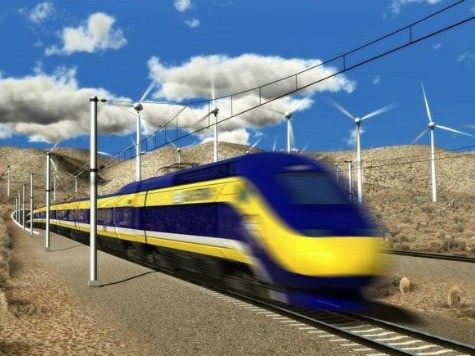The Great California Train Robbery is moving into full gear after nine foreign bidders responded with “expressions of interest” in building a fleet of electric trains for a proposed high-speed rail system. Perhaps best for California politicians is that there are no major U.S. manufacturer’s interested. That means Governor Brown and his Legislator allies will need to go on junkets to such exotic locations as China, France, Saudi Arabia, Germany, Italy, South Korea and Canada with their new best friends.
In its 2014 “high speed rail” (HSR) business plan, the California rail authority estimated it will spend $889 million to buy the 95 vehicles for its “initial operating segment” from Merced to Burbank, now planned to start carrying passengers by 2022. When the entire Phase 1 of the statewide system is expected to be built out from downtown San Francisco to downtown Los Angeles and Anaheim in 2028, capital spending for vehicles will leap to about $3.3 billion.
There are currently just 1,300 “high speed rail” (HSR) trains in Europe and Asia that travel at speeds of 186 mph or faster. From a financial standpoint, only two HSR lines in the world are profitable: Paris-Lyon in France and Tokyo-Osaka in Japan. A third line, Hakata-Osaka in Japan, breaks even. The others are all big time losers.
Amtrak USA has lost money every year of its existence and has run up total operating and capital losses of over $40 billion. During the 2000s, Amtrak averaged annual losses in excess of $1 billion. But during the financial crisis, the American Recovery and Reinvestment Act of 2009 pumped an additional $1.3 billion of the $8 billion in high-speed rail grants into Amtrak. In 2010, Amtrak got another slurp at the federal trough with an expanded $1.563 billion in operating subsidies and capital service grants.
High-speed rail lines around the world usually require large government subsidies from both taxpayers and drivers. Even with lavish subsidies, traveling by high-speed rail is still more expensive than flying in 12 of the 23 most popular high-speed rail routes in the world. Flying would be cheaper on most other routes, if they are served by discount airlines. For routes that are less than 150 miles, intercity coach buses are much cheaper and take only slightly longer than high-speed trains. The only “sweet spot” for HSR competitiveness are routes between 200 and 500 miles in length.
HSR are also very expensive to build. Most new routes cost at least $10 million per mile to build. The cheapest European HSR annual operating costs are over $50,000 per seat. Roughly speaking, that means that 80% of HSR seats must be full every work day just to break even.
According to a Reason Foundation study, an HSR line needs ridership of between 6 million to 9 million passengers per year just to break even. The sort of high-speed Amtrak Acela line operating in the busy Northeast Corridor averages only 3.4 million passengers per year.
The international number of rail passengers has fallen by over 10% due to the rise of discount airlines around the world. Rail proponents argue rail travel will increase, since many U.S. airports are already operating at capacity. But the FAA is rolling out the Next-Gen air traffic control system that will utilize space-based satellites instead of land-based radar to align plane traffic hundreds of miles away. The system is expected to increase the number of landings and take-offs at congested airports by over 20%.
Rail enthusiasts claim that Europe’s and Asia’s HSR are examples of what the U.S. could accomplish. But the demographics of the U.S. are unique. New York City, the densest U.S. city, is only about half as dense as London or Barcelona and about a third as dense as Shanghai.
Americans also have far higher rates of car ownership than most other countries, because the cost of using a personal vehicle is cheaper. Federal, state and local gas taxes in the U.S. average around $0.50 per gallon, while many European and Asian countries charge $5.00 in tax.
Major U.S. companies, like GE and GM that make locomotives, have no interest in California high speed rail because it can never be financially viable. But over the next couple of years, Governor Jerry Brown and his Legislature allies have almost a billion dollars in choo-choo-train cash to make lots of new foreign friends.

COMMENTS
Please let us know if you're having issues with commenting.